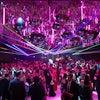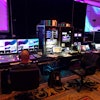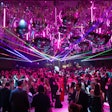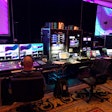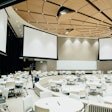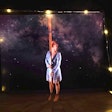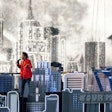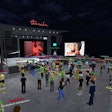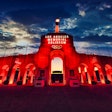
The Summer Olympic Games kicked off its 2016 edition in Rio de Janeiro, Brazil, on August 5 with an opening ceremony that highlighted the history of the vibrant city and the rest of the country. Unlike many recent ceremonies, the live event—which was produced by Marco Balich, designed by Fernando Meirelles and Daniela Thomas, and held at the Maracanã Stadium—focused less on dazzling light displays (although there were some striking projections) and more on performers, music, and a distinct message about global warming. Despite economic turmoil, the Zika virus, and polluted sailing waters being less-than-ideal factors at the forefront of the Games, the opening event proved that Rio is ready to host the Olympics. Event producers from across the country gave BizBash their thoughts on what they liked and disliked about the ceremony, including 3-D mapping illusions, a global warming message, and Gisele Bündchen's catwalk.
Claudine Goin and Kristen Couchot
Goin: “You can tell they were extremely thoughtful of how things would look on screen for those watching at home, and what would work well in the stadium. While kite flying, paragliding, and capoeira are all great things found in Brazil and part of the culture, to me that translated into a lot of things happening in the air making the aerial shots of the country resonate even more.
They did an amazing job with the use of some key set and theatrical pieces, puppetry, pyrotechnics, and lighting, but the success overall was in the use of projection—which was done brilliantly. It made this low-budget production feel like it had all the money in the world, particularly when it worked with the dancers and various forms of scrim and fabric. For example, although reminiscent of Missy Elliott’s puffy trash bag suit in her late ‘90s ‘I Can’t Stand The Rain’ video, the use of the projection floor with the silver dancers was stunning.
I would've used the projection screen to highlight Gisele Bündchen’s final catwalk to make it look less like watching someone take a very long, boring walk. Maybe light her path in some dynamic way or do something creative to each step she took, or even have lighting and projection interact with her movement more.
The biggest success was in the storytelling. They focused on the unabashed history of Brazil, from the rainforest and indigenous people to its history of slavery and its now diverse culture. At the end of the story, it brought out the fun that is also part of the diverse Brazilian culture through music, dancing, and vibrant colors.”
Couchot: “After reading the news leading up to the Rio Olympics—the lack of budget and the theme being giambarra (makeshift)—I was interested to see designers Fernando Meirelles and Daniela Thomas' approach. Their storytelling was strong, and I liked the decision to showcase the various people that make up their diverse country. From a visual standpoint it was a good show, if not inspiring. I loved their use of puppetry, and the costumes overall were bright and humorous throughout.
Meirelles and Thomas were most successful, however, in speaking to their audience on an emotional level, highlighting the diversity, vivid color, and joyous music of Brazil.They made an excellent choice to highlight music and culture over technology and dazzle; [it was] especially appropriate given the country’s current financial and political struggles. My favorites included the national anthem performed by Paulinho Da Viola and the gorgeous kinetic ‘sun’ sculpture that shimmered behind the Olympic fire cauldron. Gisele’s flashing metallic gown made a stark and memorable contrast to the inky black floor in her final appearance on the catwalk.
I would have liked to have seen more interaction between projection and performers. One cool optical illusion moment was marred by performer missteps when a dancer walked on an ‘alley’ between buildings when he should have jumped. I agree that the projection floor could have been better used during Gisele’s walk. And some of the props seemed to be geared more towards the stadium guests—they didn’t look quite as nice in the televised close-ups as they did in the wide shots.”
Letter grade: B+
Goin and Couchot are senior producers at Production Glue, a New York-based live events agency. Clients and events include Nike, Comic-Con International, and One World Trade Center.
Ron Nicynski
“Overall, the show's blend of simple materials and digital video mapping, with a reliance on the choreography and artists onstage, was very tastefully done. The ceremony felt genuine—with Brazil likely wanting to show the world what the Games symbolized to their country. The smaller budget still had a dramatic impact, especially when delving into the country's varied and volatile history through movement, lighting, and sound. I especially appreciated Fernando Mereilles' incorporation of different art forms into a singular experience: theater, dance, cirque, film, fashion, culture.
The most memorable parts for me began with the mylar-material dancers, as much a synchronized swimming act as anything—very minimalistic, set the tone for the entire show. The incorporation of water at the start seemed to me an almost cleansing moment for the event as a whole, considering the fears and anxiety leading up to [opening night] and these Olympic games. From there, I enjoyed the interweaving of the strings by the native inhabitants, the building jumpers on the digitally enhanced ‘city,’ and the diverse music used throughout the production to represent the various cultures and history of the country.
Gisele’s catwalk felt flat and forgettable. The middle of the ceremony’s focus on the history of dance and music was non-cohesive and felt forced. This should have been one of the most invigorating and fun parts of the production, but instead I wasn't emotionally engaged or moved at all.
The step back to a simpler time of physical theatrics felt refreshing when compared to some of the most recent productions. So many modern Opening Ceremonies have relied on heavy production, technology, and pyrotechnics that the history and culture of host nations have seemed almost inconsequential to the entertainment value and ‘wow’ factor. Against the landscape of recent volatile political activity across the globe, the Rio ceremony focused more on the people and the art form versus the politics, and that felt appropriate at this juncture in time.
The smaller cauldron compared to years past was unexpected, but it was an impressive design and still served a dramatic purpose. The reasoning for the smaller cauldron was also well thought-out.
Rio is so world-renowned for Carnival that I would have liked to see more traditional Carnival costumes—large, overstated feathers and head pieces—and entertainment during the diverse musical section in the middle of the program. This was a lost opportunity to create an energy and vibrancy that the show was lacking. The finale also felt more like a repeat of years past when there was a chance to be original and creative.”
Letter Grade: B+
Nicynski is the senior director of events strategy and development at Hargrove, an event company based in the Washington, D.C. area that specializes in experiential marketing production. Hargrove's projects have included the National Press Foundation Awards and the AIPAC Policy Conference, and the company recently served as the general contractor for the Democratic National Convention.
Bonnie Ott
"Creatively, the assets—mainly the projection—made a great impact in transforming the experience for those of us watching on TV. However, for me, the true impact was in how they brought the story and history of Brazil to life through vibrant colors, design, music, and dance. My favorite parts included the integration of fabric, lighting design, and choreography for the rainforest; using a global platform to artistically recognize issues that are relevant to people around the globe—including global warming, acknowledging conflict, and producing a piece that sheds light on the slave trade—which I don’t believe any other Olympic hosts would dare to include; and the celebration of their blended culture. I’ve never been to Carnival, but I felt like I wanted to get up and dance. It was sexy, it was fun, and it made you feel like you wanted to join the party. The cityscape was also a ‘wow’ moment. The use of projection to create a moving cityscape while perfectly executing precise choreography was impressive.
Overall, it was a bit gritty. Not everything was so polished and I think that is a good thing. Not every award-winning event production is associated with a large budget. During the part where the music and dancing really started to pick up, Daniela Thomas commented that these individuals have ‘incredible creativity, with little opportunity.’ Given the current environment, this quote pretty much summed up this entire opening ceremony for me."
Letter grade: B
Ott is the founder and C.E.O. of Studio B Entertainment, a Chicago-based consulting firm specializing in influencer and consumer brand experiences with a focus in entertainment marketing, beauty, lifestyle, hospitality, and culinary. Clients include Essence and InStyle.
Becca Lyon
“Brazil didn’t shy away from its past and didn’t let its current state deter them from celebration, which showed a lot of courage and resilience. The country embraced its history, both good and bad, in its storyline. Throughout the entire ceremony, you could feel the country’s love of heritage and patriotism.
I liked the lighting of the Olympic flame and their choice in Vanderlei Cordeiro de Lima as the final bearer. Once you understand his backstory, the entire segment drew an emotion that every Olympic opening ceremony should provide. What was seemingly a very underwhelming cauldron brought the audience by surprise as it rose to the center of a beautifully designed solar system-like rotating production that left me in awe. I also liked the use of projection mapping to make up for lack of budget. Projection mapping is a production element that easily captivates an audience’s attention and draws an amount of curiosity. Given the budgetary circumstances, I think this was a win on their part.
I didn’t like the lack of cohesion throughout the entire production. The opening performance, which should be the most exciting and ‘goosebump-worthy’ moment, was a let down. Brazilian musical acts were added in what seemed a nonsensical manner, partnered with mostly unsynchronized dancing and a poorly lit dance party that seemed to be more of a time-filler than an inclusion into the narrative as a whole. The inclusion of global warming was a great opportunity for awareness, but placement of the segment fell short with it following a large celebratory moment. The length and depth of the subject brought a heavy feeling of gloom over an audience who should feel joyous upon the start of the games. And the lack of budget, though unavoidable, was an unfortunate hindrance on making this ceremony stand with the likes of London and Beijing. Knowing that the show would be lacking in scenic elements due to budget, I would have spent more time on perfecting the performance elements and creating more seamless transitions between the various entertainment pieces."
Letter grade: C+
Lyon is the marketing communications manager at AgencyEA, a Chicago-based experiential and event marketing agency. Clients include Hilton Worldwide, Target, and AOL.
Rrivre Davies
“I love to see how people express themselves to the world, and what message or messages they feel is most important to them. Not surprisingly, the use of bodies in motion was a major theme in the whole ceremony, and with Brazil being a country of such freedom of expression, that seemed very fitting. I also noticed how subdued the national anthem composition was, perhaps because Brazil really wants to welcome the world and not make it all about them.
Another creative choice I found interesting—and perhaps in contrast with much of our own political correctness—was that it embraced and celebrated Brazil’s background, from the indigenous to the colonial heritage (which of course includes the tormenting reality of slavery). In a country such as Brazil, where their very identity is their blending of the past, it seems they have come to terms with this. I felt a very simplistic elegance about the choices they made, and in many ways it felt like an intellectual party—more like a folk story than a huge celebration. In many ways it also felt like a coming-out party; Brazil saying to the world, ‘Yes, this is our past and it is a varied and conflicted past, but we love ourselves and so can you if you look beyond yourselves.' It was clearly a proud moment for all the peoples of Brazil.
I did feel some parts were a little abstract even if you know the history and culture of Brazil, and without scripted narration from the TV anchors I feel certain elements such as the class conflict would not have been understood.”
Letter Grade: B+
Davies is the owner of Rrivre Works, a Los Angeles-based custom luxury event design and rental house. Clients have included the California Science Center, the United Negro College Fund, and the International Live Events Association.
Isabel Chattas
“It was very Brazilian. And this is absolutely the best and biggest compliment that I can pay to the opening ceremony. Kudos to the team that put the show together, because we all know that budget was a big issue. The producers decided to keep it simple and use mapping as the axis to the show, and it absolutely worked. I loved the fact that the show was less, because for me it was more and very true to what Brazil does best: Celebrate! And it was always truthful and representative of Rio and its magic.
My favorite moment of the show, by far, was when the mapping created the illusion of buildings raising from the floor and the dancers leaping across rooftops. This particular sequence was for me the best use of mapping that I have seen. It goes to show that mapping still has a lot of great uses. The simplicity of the structure, coupled with the great projection and colors, brought the favelas to life. Dancers dressed in white (which for Brazilians is the color of new beginnings) were just the perfect complement and really translated to the world a very stylized vision of the slums in which much of Brazil’s cultural richness is born. One thing I loved was that Brazilians used the ceremony to share with the world their history and views, including who was—in their eyes—the first person to fly. It was a simple idea that told a lot about Brazil’s pride.
The media is in a frenzy and there are people on both sides of the fence about Gisele becoming the Garota d’Ipanema. However, I have to say that I loved the simplicity of the concept and how well it fit with the show.
Although I love that Brazil incorporated the very important topic of global warming and put it in the forefront, I feel that it got lost and was a tad depressing in the midst of the celebration. I would have preferred a more positive message. Some of the dance sequences at the beginning of the show (telling the story of the rainforest, its first inhabitants, and then the different immigrations) felt a tad long and dragged.
Overall, the choice of the mapping and the big oddly shaped center stage was brilliant. It was a great solution in which spectacular and colorful images told the story of Brazil. I also loved the countdown with the silver kevlar cushion. The intensity of the video combined with a strong storyline about Brazil’s rich and diverse racial diversity delivered the perfect backdrop for the very artistic rendition of Rio’s spirit and joy de vivre."
Letter grade: A
Chattas is the co-founder and chief creative officer of Siinc Agency, a Miami-based experiential marketing and live communications agency. Clients include Audi, MasterCard, and Bacardi.
Mistyka Garcia
“In addition to the oiled up, shirtless flag bearer from Tonga, a couple fierce moments on the cat walk, and the heartfelt greeting given to the first-ever Olympic refugee team, the Avatar-inspired performance had a brilliant, subtle, yet powerful message, giving a nod at respecting our planet and embracing the human race regardless of our differences. The use of projections combined with 3-D elements and entertainment has just set the industry bar higher for all of us. I'm motivated and inspired by the challenge.”
Letter grade: B+
Garcia is the owner of Special Occasions Events, a Los Angeles-based event production and design company. Events include the Adobe Max Bash and the Diamond Ball.
